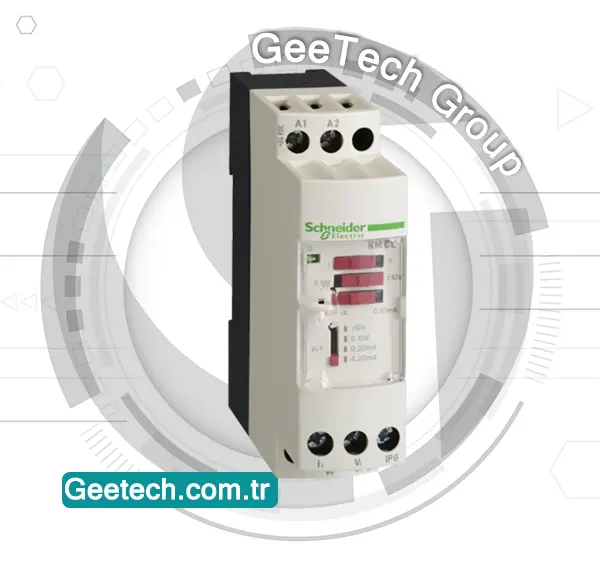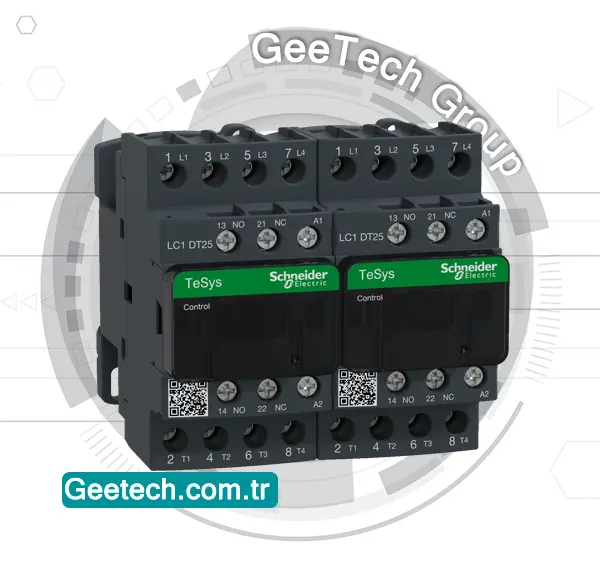RMCL55BD
Voltage or current converter, Harmony Analog, Isolated 0…20mA
- Stock status:
- In stock
- Manufacturer:
- Schneider
- Product code:
- RMCL55BD
Main documents
| Range of Product | Harmony Analog |
|---|---|
| Product or Component Type | Voltage/current converter |
| Analogue input type | Current 0…20 mA Current 4…20 mA Voltage +/- 10 V DC Voltage 0…10 V DC |
| Analogue output type | Current 0…20 mA <= 500 Ohm switchable Current 4…20 mA <= 500 Ohm switchable Voltage +/- 10 V >= 100 kOhm switchable Voltage 0…10 V >= 100 kOhm switchable |
| Protection Type | Reverse polarity protection on output Short-circuit protection on output Overvoltage protection on output (+/- 30 V) |
|---|---|
| abnormal analogue output voltage | 11…15 V – 10…10 V no input or input wire broken voltage 11…15 V 0…10 V no input or input wire broken voltage -15…0 V 0…20 mA no input or input wire broken current -15…0 V 4…20 mA no input or input wire broken current |
| abnormal analogue output current | 22…30 mA 0…20 mA no input or input wire broken voltage 22…30 mA 4…20 mA no input or input wire broken voltage -30…0 mA 0…20 mA no input or input wire broken current 4…30 mA 4…20 mA no input or input wire broken current |
| [Us] rated supply voltage | 24 V DC +/- 20 %, isolated |
| Current consumption | <= 70 mA voltage output <= 90 mA current output |
| Local signalling | For power ON LED (green) |
| Measurement error | +/- 5 % of full scale20 °C temporary performance degradation when subject to electromagnetic interference) |
| Repeat accuracy | +/- 0.2 % full scale 20 °C +/- 0.6 % full scale 60 °C |
| Temperature coefficient | 200 ppm/°C |
| Clamping Connection Capacity | 2 x 1.5 mm² 1 x 2.5 mm² |
| Tightening torque | 5.31…9.74 lbf.in (0.6…1.1 N.m) |
| marking | CE |
| Surge withstand | 0.5 kV 1.2/50 µs IEC 61000-4-5 |
| [Ui] Rated Insulation Voltage | 2 kV |
| Fixing mode | By screws (mounting plate) Clip-on (35 mm symmetrical DIN rail) |
| Safety reliability data | B10d = 20000 MTTFd = 21.6 years |
| Net Weight | 0.26 lb(US) (0.12 kg) |
| Standards | IEC 60947-1 IEC 60584-1 |
|---|---|
| Product Certifications | UL GL CSA |
| IP degree of protection | IP20 terminal block) IP50 housing) |
| Fire resistance | 1562 °F (850 °C) IEC 60695-2-1 1562 °F (850 °C) UL |
| Shock resistance | 50 gn 11 ms IEC 60068-2-27 |
| Vibration resistance | 5 gn 10…100 Hz)IEC 60068-2-6 |
| Resistance to electrostatic discharge | 6 kV in contact)IEC 61000-4-2 level 3 8 kV in air)IEC 61000-4-2 level 3 |
| Resistance to fast transients | 1 kV IEC 61000-4-4 on input-output) 2 kV IEC 61000-4-4 on power supply) |
| Disturbance radiated/conducted | CISPR 22 group 1 – class B CISPR 11 |
| Ambient Air Temperature for Storage | -40…185 °F (-40…85 °C) |
| Ambient Air Temperature for Operation | 32…122 °F (0…50 °C) mounting side by side 32…140 °F (0…60 °C) 2 cm spacing |
| Pollution degree | 2 IEC 60664-1 |
| Category | US10CP222375 |
|---|---|
| Discount Schedule | 0CP2 |
| GTIN | 3389110108897 |
| Returnability | Yes |
| Country of origin | ID |
| Unit Type of Package 1 | PCE |
|---|---|
| Number of Units in Package 1 | 1 |
| Package 1 Height | 1.06 in (2.7 cm) |
| Package 1 Width | 3.23 in (8.2 cm) |
| Package 1 Length | 3.35 in (8.5 cm) |
| Package 1 Weight | 4.20 oz (119.0 g) |
| Unit Type of Package 2 | S02 |
| Number of Units in Package 2 | 47 |
| Package 2 Height | 5.91 in (15 cm) |
| Package 2 Width | 11.81 in (30 cm) |
| Package 2 Length | 15.75 in (40 cm) |
| Package 2 Weight | 13.54 lb(US) (6.14 kg) |
Product Description
Schneider Electric
Schneider Electric is a multinational corporation specializing in energy management and automation solutions. With operations in over 100 countries, the company offers a wide range of products and services for various industries, including residential, commercial, and industrial.
Schneider Electric is focused on sustainability and innovation, aiming to help their customers manage energy efficiently and reduce their environmental impact.
Schneider Electric Push Button
Schneider Electric offers a wide range of push buttons, designed for various industrial and commercial applications. Schneider Electric Push Buttons are high-quality, durable, and reliable components used to control electrical circuits in industrial, commercial, and residential settings.
They come in various types, sizes, and colors to meet the diverse needs of different applications. These push buttons are part of the Harmony range, known for its user-friendly design and robust performance.

Se Relays
Harmony Analog Relays by Schneider Electric are essential components designed for a wide range of industrial applications. These relays are renowned for their reliability, precision, and versatility, making them ideal for monitoring and controlling various parameters such as voltage, current, temperature, and more.
Key Features:
- Precision Monitoring:
– Harmony Analog Relays provide accurate monitoring of analog signals, ensuring precise control and protection of electrical equipment. - Versatility:
– These relays are suitable for a variety of applications, including process control, automation, and energy management. - Robust Design:
– Built to withstand harsh industrial environments, Harmony Analog Relays are durable and offer long-lasting performance. - Easy Integration:
– Designed for seamless integration into existing systems, these relays come with user-friendly interfaces and flexible mounting options. - Advanced Functionality:
– Equipped with advanced features such as adjustable thresholds, time delays, and multi-function capabilities to meet complex application requirements.
Harmony Analog Relays by Schneider Electric are a vital component for ensuring the reliability and efficiency of industrial systems. With their advanced monitoring capabilities and robust design, these relays provide precise control and protection for a wide range of applications.
RMCL55BD
The Schneider Electric RMCL55BD is a versatile voltage or current converter, part of the Harmony Analog range, designed to facilitate the conversion of the most common signals in industrial applications.

Key Features:
- Model: RMCL55BD
- Type: Voltage or Current Converter
- Range: Harmony Analog
- Signal Conversion: Converts a variety of input signals to corresponding output signals, enhancing compatibility between different devices and systems.
- Voltage Range: 0V to 10V, ±10V
- Current Range: 0mA to 20mA, 4mA to 20mA
- Voltage Range: 0V to 10V, ±10V (switchable)
- Current Range: 0mA to 20mA, 4mA to 20mA (switchable)
The Schneider Electric RMCL55BD voltage or current converter is an essential component for industrial signal conversion, providing isolated and reliable signal transmission with versatile input and output options. Its compliance with international standards and certifications, combined with its ease of use and secure settings, make it an ideal choice for enhancing compatibility and performance in diverse industrial applications.
Frequently Asked Questions
What is a push button used for?
✅When you press a push button, it either makes or breaks an electrical connection, allowing or interrupting the flow of electricity through the circuit. Pushbutton switches are commonly used in a wide range of electronic devices, control panels, and applications where users need to activate or deactivate a function or operation. These switches are essential for ensuring reliable and efficient control in various settings, from industrial machinery to consumer electronics and automation systems.
What is NO and NC in Push Button Switches?
✅ Push button switches can be classified as either normally open (NO) or normally closed (NC). Normally open (NO) switches, also known as "OFF" position switches, complete the circuit when actuated. In contrast, normally closed (NC) switches, or "ON" position switches, break the circuit when actuated. Understanding the difference between NO and NC push button switches is crucial for selecting the right type for your application, whether it's for industrial machinery, control panels, or electronic devices.
What Are the Two Types of Push Button Switches?
✅ Push button switches come in two main types: single-pole and double-pole switches. The single-pole switch is the most common type, featuring a control device with a single input source and a single output source. This basic design makes single-pole switches ideal for a wide range of applications. Double-pole switches, on the other hand, have two input sources and two output sources, offering more complex control capabilities for advanced electrical systems.
Is a Push Button a Sensor?
✅No, a push button is not an analog sensor. An analog sensor provides a continuous output signal that varies in proportion to the measured quantity. In contrast, a push button provides a discrete output signal that changes state from one level to another when the button is pressed or released. This distinction makes push buttons ideal for applications requiring simple on/off control, unlike analog sensors that are used for more complex, variable measurements.
What is Inside a Push Button?
✅ A push button consists of several key components:
1. Button Actuator: This is the part you physically press. It is connected to an internal mechanism within the switch.
2. Contacts: Push button switches contain one or more sets of contacts, typically made from conductive materials like metal. In their default state, these contacts are separated.
When the button actuator is pressed, it moves the contacts together to complete an electrical circuit. This simple yet effective design is what makes push buttons reliable for various applications, from industrial machinery to everyday electronic devices.
Is a Push Button Digital or Analog?
✅A push button is a digital sensor. Unlike analog sensors, which provide a continuous range of values, digital sensors like push buttons have only two states: on or off. For example, when you press a push button, it changes from off to on, providing a discrete signal. Similarly, a digital light sensor can detect whether it is dark or bright, also giving a binary output. This clear distinction makes push buttons ideal for simple, straightforward control in various applications.
























Değerlendirmeler
Henüz değerlendirme yapılmadı.